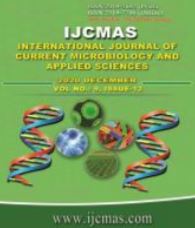


 National Academy of Agricultural Sciences (NAAS)
National Academy of Agricultural Sciences (NAAS)

|
PRINT ISSN : 2319-7692
Online ISSN : 2319-7706 Issues : 12 per year Publisher : Excellent Publishers Email : editorijcmas@gmail.com / submit@ijcmas.com Editor-in-chief: Dr.M.Prakash Index Copernicus ICV 2018: 95.39 NAAS RATING 2020: 5.38 |
The two spotted spider mite, Tetranychus urticae Koch (Acari: Tetranychidae) is the most destructive phytophagous species. T. urticae is particularly dominant and destructive in intensive cultivation, high-yield cropping systems, and affect crops by direct feeding. In severe infestations, it reduces the area of photosynthetic activity and causes leaf abscission. Populations can increase rapidly especially during hot and dry periods. T. urticae may develop 15–20 generations per crop of open cultivation and up to 30 generations, in protected cultivation where high value flower crops like carnation is grown. Farmers rely only on acaricides and insecticides on the management of T. urticae in carnation. Acaricide resistance in phytophagous mites is seriously increasing phenomenon, especially in T. urticae. Hence, a survey was carried out in Kothagiri areas to study the acaricide usage pattern in carnation during 2018-19. The results of bioassay revealed that that LC50 values for fenazaquin was 418.3 and 599.37 and for propargite it was 373.33 and 319.64, respectively in Kurkuthi and Kapati population. Resistance ratio of 217.86 and 312.17 for fenazaquin and 272.50 and 233.31 for propargite was recorded in Kurkuthi and Kapati population, respectively.
 |
 |
 |
 |
 |